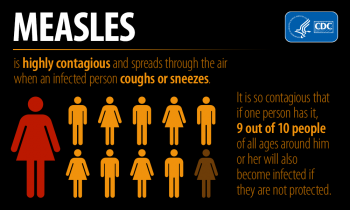An Update on Measles
August 15, 2019

Although no cases have been seen in Vermont this year, Montreal has had a recent outbreak of measles. In addition, all the states bordering Vermont, including New Hampshire, New York and Massachusetts, have had outbreaks this year. Measles is one of the most contagious of all diseases, and Vermonters need to be aware :
The measles virus stays in the air for up to two hours after an infected person leaves an area. Someone with measles can pass it to others from four days before the rash appears to four days after the rash appears. Before someone even knows they’re sick, they can spread measles to other people.The incubation period for measles is six to 21 days.
The first symptoms can include:
- Fever – Up to 104ºF (40ºC).
- Feeling sick, like with a cold.
- Loss of appetite.
- Spots in the mouth – These can look like grains of salt.
After the first symptoms, many people have:
- Red, runny eyes. The eyes might also be extra sensitive to bright light.
- Sneezing and coughing.
- A red rash that starts on the face and spreads to the body. The spots in the rash can form red patches.
- A sore throat.
- Most people start feeling better about two days after the rash starts. After three or four days, the rash starts to turn brown and go away. The skin might peel or flake off, like after a sunburn. Many people have a cough for one or two weeks after the rash goes away.
- Some people who get measles have other symptoms, such as a headache, chest pain, or breathing problems.
About nine in ten people with close contact to a person with measles will get the disease if they are not vaccinated.
Measles is preventable when people get vaccinated. Keeping measles immunization levels high in our communities is critical to preventing measles outbreaks. Measles is still common in many other countries and may be brought into the United States by unvaccinated travelers.
You are protected from measles if any of the following apply:
- You were born before 1957 or
- You have laboratory confirmed evidence of immunity to measles or
- You have documentation of measles vaccination. Check the table below for the recommended vaccine dosage based on age:
AGE | DOSE OF MEASLES VACCINE (INCLUDES MMR) |
|---|---|
Children 12 months through 4 years of age | 1 dose |
School-aged children (grades K-12) | 2 doses |
Adults at high risk (students at post-high school education institutions, healthcare personnel and international travelers) | 2 doses |
All other adults* | 1 dose |
International travelers that are infants aged 6-11 months | 1 dose |
International travelers that are older than 12 months, but born during or after 1957 | 2 doses |
*Adults born during or after 1957:
If you got the measles vaccine sometime between 1963-1967, you may have gotten an early version of the vaccine that was not effective. This early version was made from an inactivated virus. Check with your doctor about being revaccinated with at least one dose of MMR.
If you were vaccinated with an unknown type of measles vaccine or you cannot provide documentation of vaccination, check with your doctor about being vaccinated with at least one dose of MMR.
Measles is a serious disease that can lead to hospitalization and even death. Measles is deadly in one or two out of 1,000 children who become infected. Measles is especially severe in people with weak immune systems. Many people with measles have complications like: Diarrhea, Ear infections, Pneumonia, Acute encephalitis, or a brain infection that can lead to permanent brain damage. In rare cases, a fatal disease that develops seven to 10 years after measles infection, called subacute sclerosing panencephalitis. Getting measles during pregnancy increases the risk of premature labor, miscarriage and low birth weight infants.
https://www.uptodate.com/contents/measles-the-basics?search=measles&topicRef=3021&source=see_link
https://www.cdc.gov/measles/about/faqs.html